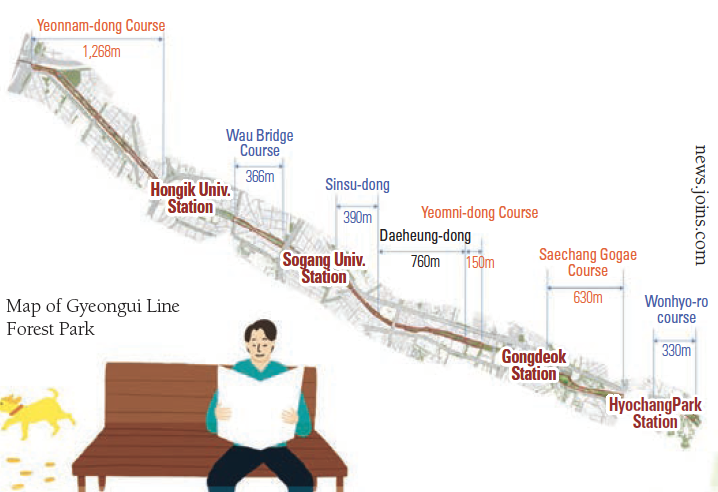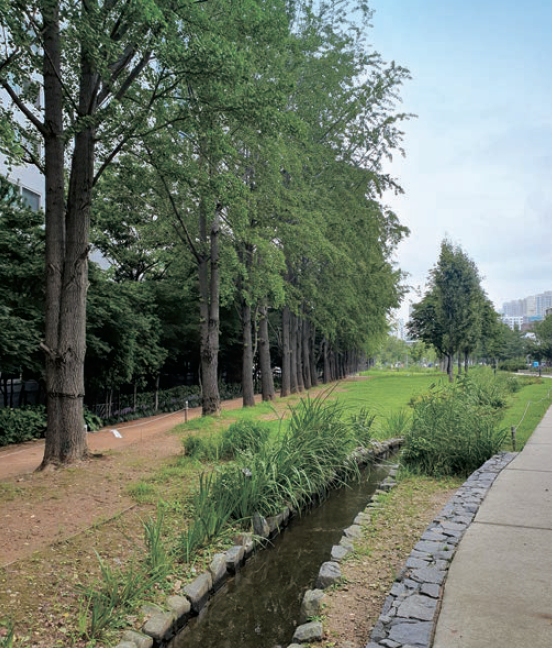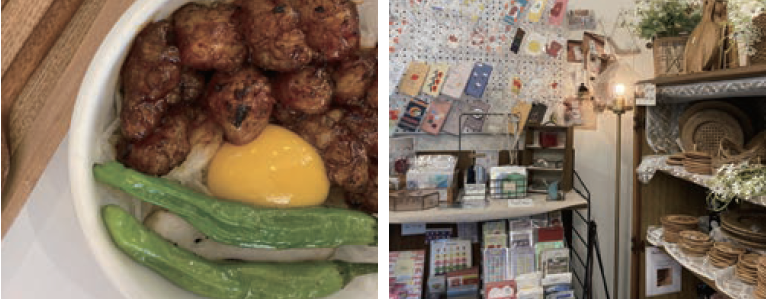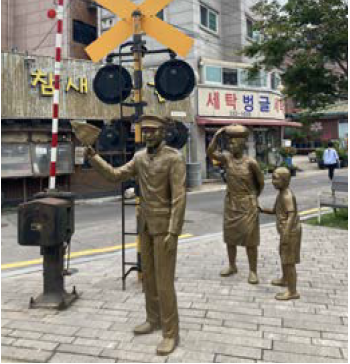Autumn is coming. It is getting cooler these days. If Kingos do not want to go far away in this good weather, they can stroll through the urban center and buildings. Gyeongui Line Forest Park is an urban park where an abandoned railway was reborn for citizens. The Sungkyun Times (SKT) walked along Gyeongui Line Forest Park, also famous for Yeontral Park, where people casually pass by.
Makeover of Old Railway as a Place for Citizens
History of the Gyeongui Line
The Gyeongui Line is a double-track railway connecting Seoul and Sinuiju. The Japanese built this line between 1904 and 1906 to secure control over the Korean peninsula and launch an invasion of China. As the main railway traversed the Korean peninsula vertically, along with the Gyeongbu Line, the Gyeongui Line had the highest traffic volume among all railways in Korea. Although it continued to operate after the division of South and North Korea in 1945, the operation was suspended after the Korean War. At the Inter-Korean summit in June 2000, however, a discussion began about the details of a project to reopen the Gyeongui Line. On June 14th, 2003, a ceremony to mark the re-connection of the railway was held at the Military Demarcation Line (MDL). In 2008, as Yongsan Station to Gajwa Station on the Gyeongui Line became undergrounded, the remaining place was constructed into a rest area for citizens as a part of an urban regeneration project.
Gyeongui Line Forest Park
The park is designed with motifs based on the memories and remnants of the old Gyeongui Railway. The reconstruction was completed in 2016 and is currently 6.3km-long. The park stretches from Hyochang Park to Gajwa Station. Thanks to the park, Mapo-gu and Yongsan-gu got more green areas, encompassing residential areas from downtown areas. It also contributes greatly to the local community such as forming new business districts. It takes about two and a half hours to walk the length of the park.

How to Go
When departing from the Humanities and Social Sciences Campus: Take the subway on Line 4 at Hyehwa Station. Transfer to Line 2 at Dongdaemun History & Culture Park Station and get off at Hongik University Station (approximately 40 minutes) When departing from the Natural Sciences Campus: Take the subway on Line 1 at Sungkyunkwan University Station. Transfer to Line 2 at Sindorim Station and get off at Hongik University Station (approximately 1 hour and 10 minutes)
Walk Along Gyeongui Line Forest Park
Yeonnam-dong Course

The Yeonnam-dong course, which starts from Exit 3 of Hongik University Station, is the hottest place on the Gyeongui Line these days. It is also called Yeontral Park because it reminds people of the image of Central Park in New York. The large area of lawn and trees calm the heat around Hongik University. When fall comes, a 1km-long ginkgo tree road along the railroad tracks becomes a beautiful trail with flying yellow ginkgo leaves. A streamlet, which ows through the center of the park, is made by raising underground water and symbolizes Segyocheon Stream that has now disappeared.
1. Around the Alleys
Walking along the forest path is good, but another charm of Yeonnam-dong can be found in its alleys. The alleys stretch like a branch around the park. There are various dessert cafes, restaurants, select shops, and workshops. Kingos may find eyecatching shops on the way looking for a popular restaurant. Shops with unique and sensuous interiors make the alleys really colorful.

2. Dongjin Market
In the Yeonnam-dong back streets, the old traditional market has been replaced by young and creative merchants, creating a new vitality. Originally, Dongjin Market was a normal traditional market in the city with small shops. Due to a hypermarket, the number of visitors to the traditional market decreased, so it was used as a warehouse for nearby stores. After this, Hongdae business district expanded to Yeonnam-dong, however, Yeonnam-dong became full of young artists. Every Friday to Sunday, there is a ea market where young artists gather to sell handmade creations such as candles, perfumes, and accessories. This takes place on Fridays from 2:30 p.m. to 8:00 p.m. and Saturday to Sunday from 1:30 p.m. to 7:30 p.m.

Wau Bridge Course
The Wau Bridge Course is sometimes called Tang-Tang Street because a crossing barrier used to make a ‘Ttang-Ttang’ sound when a train passed along the old railroad. It has good accessibility because it is located between Sinchon and Hongdae. Also, it is a relatively quiet place compared to the nearby busy streets, so it is good to take a rest there.

1. Gyeongui Line Book Street
Gyeongui Line Book Street, from Exit 6 of Hongik University Station to Wau Bridge, is a culturally complex place for books. It offers various cultural experience programs, exhibitions, reader-writer meetings, book concerts, and so on. The trainshaped booth displays and sells books by dividing themes into humanities, literature, travel, and art walks. Gyeongui Line Bookstore closes on Mondays and opens on Tuesdays to Sunday, from 11 a.m. to 8 p.m. The exhibition Our [ ] Space runs from August 14th to September 13th. To keep a social distance, it takes reservations of up to 10 people per hour to focus on books in private space.

Sinsu-dong Course
The 420m-long forest road that runs from Sogang University Station to Daeheung Station is called the Sinsu-dong course. Previously, the road between Wau Bridge and Sinsudong was cut off due to the road and buildings. After the Sogang Sky Bridge was installed, they became connected. Compared to the crowded Yeonnam-dong and Wau Bridge courses, Sinsu-dong is tranquil. Kingos may take a walk in peace. Underground water from the airport railroad is raised to reproduce an arti cial stream Seontongmulcheon, which was created when Korea was under Japanese rule. Also, people can find sculptures and remaining railroad tracks. The cultural space Soomdo, which runs exhibitions, lectures, and book cafes, and Mapo Art Center where visitors can enjoy various performances and exhibitions are located within a 10-minute walk.

If You Want to Walk More
Yeomni-dong and Daeheung-dong courses are surrounded by residential areas, and most of the walkers are residents taking a walk in a quiet and comfortable atmosphere. In the Saechang Gogae course, east of Gongdeok Station, there is an observatory overlooking Namsan Mountain and N Seoul Tower. In the Wonhyo-ro course, a history wall commemorating the old Gyeongui Line has been installed.
These days, people are looking for a place where they can take a walk while keeping their distance and wearing masks. Let’s get out of the enclosed spaces and walk through Gyeongui Line Forest Park that runs through the city center to feel nature.
